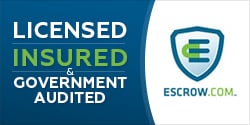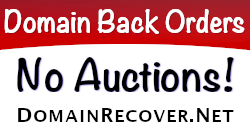In 2011, an inventor named Jamie Siminoff brought together a team of 5 engineers to work out of his garage to create a product that would become DoorBot; a doorbell system that allows you to see and speak to visitors from your smartphone.
This small team - with a lack of real funding - was able to launch DoorBot to the public in December 2012 and started to ship orders less than a year later. After appearing on Shark Tank in 2013 (and failing to attract an investment from the Sharks), DoorBot raised $5.5mm in funding and rebranded to Ring in late 2014. Of course, they also acquired Ring.com.
On Ring's blog, Jamie Siminoff describes the name DoorBot as being "too techie" as they became a mainstream product. He also notes that Ring has two meanings; firstly the sound that a doorbell makes, and secondly for the ring of security that is created around your home by using a Ring doorbell system.
Jamie Siminoff is now Chief Inventor and Founder of Ring, and I was very grateful to him for taking some time to take part in our Inside Interviews series. Many of the details of the purchase of Ring.com remain confidential, but Jamie gave us all he could disclose about the domain and his company below.
1. Can you give us a background of your company?
Ring makes the wifi video doorbell for your smartphone that allows you to see and speak with visitors from anywhere using your smartphones or tablets.
2. Why did you decide to rebrand from DoorBot to Ring?
DoorBot was an awesome name but not a name that you can build a long lasting meaningful business around. Ring is the type of name that gives you the foundation to build something unique and special from.
3. Was there any other name you'd considered rebranding to before Ring?
No, Ring was the first name we came up with and once we had it we knew it was the name.
4. Why was Ring.com such an important purchase for you?
While I am not [into] domains as an investment I think the ultra premium ones do make a big difference. When we talk to a partner and give them an email address, [email protected], they always say "wow." Also from a viral perspective everyone can remember Ring.com. I think it is not one thing but many variables that make the ultra premium domains still valuable for companies.
5. Would you ever have considered using another domain (such as Ring.net, Ring.co or Ring.io) or was Ring.com always your target?
We were only interested in the best and .com is still the gold standard around the world in our opinion.
6. How did you go about buying Ring.com?
With something that was such a premium domain, we went straight to the owner through their broker.
7. How did the negotiations progress in order for you to close a deal for Ring.com?
There was a lot of back and forth, and negotiations were very difficult. It took a long time.
8. Can you reveal the price you paid for Ring.com?
I will not (confidential information) but we definitely overpaid in terms of what the direct asset is worth in my opinion. However when used with the business it was a great investment.
9. Have you seen a rise in web traffic and sales that can be attributed to rebranding?
Yes, massive. [Editor's Note: the traffic and sales statistics are classified information, but I am told that sales grew by a "multiple of x" after rebranding to Ring.com]
10. Do you think you could have achieved the same level of success without owning Ring.com?
It is never one thing that creates a success; however, I think the domain has been key to our rise as a leader in the consumer electronics and security business.
--
Thanks to Jamie for taking the time to answer our questions. There are some excellent insights in his interview, especially his reasoning as to why Ring.com was important for them to acquire.
If you want to know more about Ring's home security system, here's a quick video:
Ring's Video Doorbell is available to buy at Ring.com for $199.
Amended to correct grammatical errors
Inside Interviews is a blog series profiling the buyers of high-value domain names. Find out their motives, negotiation tactics, and their opinions on popular domaining topics only on the NamePros Blog.
This small team - with a lack of real funding - was able to launch DoorBot to the public in December 2012 and started to ship orders less than a year later. After appearing on Shark Tank in 2013 (and failing to attract an investment from the Sharks), DoorBot raised $5.5mm in funding and rebranded to Ring in late 2014. Of course, they also acquired Ring.com.
On Ring's blog, Jamie Siminoff describes the name DoorBot as being "too techie" as they became a mainstream product. He also notes that Ring has two meanings; firstly the sound that a doorbell makes, and secondly for the ring of security that is created around your home by using a Ring doorbell system.
Jamie Siminoff is now Chief Inventor and Founder of Ring, and I was very grateful to him for taking some time to take part in our Inside Interviews series. Many of the details of the purchase of Ring.com remain confidential, but Jamie gave us all he could disclose about the domain and his company below.
1. Can you give us a background of your company?
Ring makes the wifi video doorbell for your smartphone that allows you to see and speak with visitors from anywhere using your smartphones or tablets.
2. Why did you decide to rebrand from DoorBot to Ring?
DoorBot was an awesome name but not a name that you can build a long lasting meaningful business around. Ring is the type of name that gives you the foundation to build something unique and special from.
3. Was there any other name you'd considered rebranding to before Ring?
No, Ring was the first name we came up with and once we had it we knew it was the name.
4. Why was Ring.com such an important purchase for you?
While I am not [into] domains as an investment I think the ultra premium ones do make a big difference. When we talk to a partner and give them an email address, [email protected], they always say "wow." Also from a viral perspective everyone can remember Ring.com. I think it is not one thing but many variables that make the ultra premium domains still valuable for companies.
5. Would you ever have considered using another domain (such as Ring.net, Ring.co or Ring.io) or was Ring.com always your target?
We were only interested in the best and .com is still the gold standard around the world in our opinion.
6. How did you go about buying Ring.com?
With something that was such a premium domain, we went straight to the owner through their broker.
7. How did the negotiations progress in order for you to close a deal for Ring.com?
There was a lot of back and forth, and negotiations were very difficult. It took a long time.
8. Can you reveal the price you paid for Ring.com?
I will not (confidential information) but we definitely overpaid in terms of what the direct asset is worth in my opinion. However when used with the business it was a great investment.
9. Have you seen a rise in web traffic and sales that can be attributed to rebranding?
Yes, massive. [Editor's Note: the traffic and sales statistics are classified information, but I am told that sales grew by a "multiple of x" after rebranding to Ring.com]
10. Do you think you could have achieved the same level of success without owning Ring.com?
It is never one thing that creates a success; however, I think the domain has been key to our rise as a leader in the consumer electronics and security business.
--
Thanks to Jamie for taking the time to answer our questions. There are some excellent insights in his interview, especially his reasoning as to why Ring.com was important for them to acquire.
If you want to know more about Ring's home security system, here's a quick video:
Ring's Video Doorbell is available to buy at Ring.com for $199.
Amended to correct grammatical errors
Inside Interviews is a blog series profiling the buyers of high-value domain names. Find out their motives, negotiation tactics, and their opinions on popular domaining topics only on the NamePros Blog.







